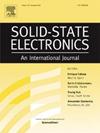Comparative effects of plasma treatments on SiO2 surface and bonding performance for wafer and hybrid bonding
IF 1.4
4区 物理与天体物理
Q3 ENGINEERING, ELECTRICAL & ELECTRONIC
引用次数: 0
Abstract
We investigate the effects of plasma on SiO2 surfaces in various plasma environments, including Ar, O2, and N2, under identical plasma conditions for low-temperature annealing in SiO2/SiO2 wafer bonding. After plasma treatments, no damage is observed on the SiO2 surface, which is comparable to post-CMP SiO2. With the Ar and O2 plasma treatments and XPS analysis, the SiO2 surface shows a Si-OH-rich surface and changes to more hydrophilic properties. Although N2 plasma treatment results in a few isolated voids being observed compared to O2 plasma treatment, N2 plasma treatment will be a suitable choice for Cu/SiO2 hybrid bonding thanks to its highest bonding strength compared to other plasma treatments and the ability to avoid Cu oxidation. On the other hand, O2 plasma treatment on SiO2 surface is the most effective way for SiO2/SiO2 wafer bonding providing excellent hydrophilicity, strong bonding strength, and minimal bonding voids.

等离子体处理对硅片和杂化键合SiO2表面和键合性能的影响
在相同的等离子体条件下,研究了不同等离子体环境下等离子体对SiO2表面的影响,包括Ar、O2和N2,用于SiO2/SiO2晶圆键合的低温退火。等离子体处理后,SiO2表面未观察到任何损伤,这与cmp后的SiO2相当。通过Ar和O2等离子体处理和XPS分析,SiO2表面呈现出富含si - oh的表面,并转变为更亲水的性质。尽管与O2等离子体处理相比,N2等离子体处理只会导致一些孤立的空洞,但由于与其他等离子体处理相比,N2等离子体处理具有最高的结合强度,并且能够避免Cu氧化,因此将成为Cu/SiO2杂化键合的合适选择。另一方面,在SiO2表面进行O2等离子体处理是最有效的SiO2/SiO2晶圆键合方式,具有优异的亲水性、强的键合强度和最小的键合空洞。
本文章由计算机程序翻译,如有差异,请以英文原文为准。
求助全文
约1分钟内获得全文
求助全文
来源期刊

Solid-state Electronics
物理-工程:电子与电气
CiteScore
3.00
自引率
5.90%
发文量
212
审稿时长
3 months
期刊介绍:
It is the aim of this journal to bring together in one publication outstanding papers reporting new and original work in the following areas: (1) applications of solid-state physics and technology to electronics and optoelectronics, including theory and device design; (2) optical, electrical, morphological characterization techniques and parameter extraction of devices; (3) fabrication of semiconductor devices, and also device-related materials growth, measurement and evaluation; (4) the physics and modeling of submicron and nanoscale microelectronic and optoelectronic devices, including processing, measurement, and performance evaluation; (5) applications of numerical methods to the modeling and simulation of solid-state devices and processes; and (6) nanoscale electronic and optoelectronic devices, photovoltaics, sensors, and MEMS based on semiconductor and alternative electronic materials; (7) synthesis and electrooptical properties of materials for novel devices.
 求助内容:
求助内容: 应助结果提醒方式:
应助结果提醒方式:


